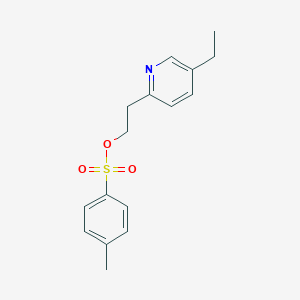
5-Ethyl-2-pyridineethanol Tosylate
- Klicken Sie auf QUICK INQUIRY, um ein Angebot von unserem Expertenteam zu erhalten.
- Mit qualitativ hochwertigen Produkten zu einem WETTBEWERBSFÄHIGEN Preis können Sie sich mehr auf Ihre Forschung konzentrieren.
Übersicht
Beschreibung
5-Ethyl-2-pyridineethanol Tosylate is a chemical compound belonging to the class of tosylates. Tosylates are esters of p-toluenesulfonic acid and are commonly used in organic synthesis due to their excellent leaving group properties. This compound is particularly interesting due to its unique structure, which includes a pyridyl group, making it valuable in various scientific research applications.
Vorbereitungsmethoden
Synthetic Routes and Reaction Conditions
The synthesis of 5-Ethyl-2-pyridineethanol Tosylate typically involves the tosylation of 2-(5-Ethyl-2-pyridyl)ethanol. The reaction is carried out using p-toluenesulfonyl chloride (TsCl) in the presence of a base such as pyridine or triethylamine. The reaction is usually conducted at room temperature or slightly elevated temperatures to ensure complete conversion.
Industrial Production Methods
Industrial production of this compound follows similar synthetic routes but on a larger scale. The process involves the use of large reactors and precise control of reaction conditions to ensure high yield and purity. The product is then purified using standard techniques such as recrystallization or chromatography.
Analyse Chemischer Reaktionen
Types of Reactions
5-Ethyl-2-pyridineethanol Tosylate undergoes various types of chemical reactions, including:
Nucleophilic Substitution Reactions: Due to the excellent leaving group properties of the tosylate group, it readily undergoes nucleophilic substitution reactions with a variety of nucleophiles.
Reduction Reactions: The compound can be reduced to form the corresponding alcohol or amine derivatives.
Oxidation Reactions: It can also undergo oxidation reactions to form various oxidized products.
Common Reagents and Conditions
Nucleophilic Substitution: Common reagents include sodium azide, potassium cyanide, and various amines.
Reduction: Common reducing agents include lithium aluminum hydride (LiAlH4) and sodium borohydride (NaBH4).
Oxidation: Common oxidizing agents include potassium permanganate (KMnO4) and chromium trioxide (CrO3).
Major Products
The major products formed from these reactions depend on the specific conditions and reagents used. For example, nucleophilic substitution reactions can yield a variety of substituted pyridyl derivatives, while reduction reactions typically yield alcohols or amines .
Wissenschaftliche Forschungsanwendungen
5-Ethyl-2-pyridineethanol Tosylate has a wide range of applications in scientific research:
Chemistry: It is used as an intermediate in the synthesis of various organic compounds, including pharmaceuticals and agrochemicals.
Biology: The compound is used in the study of biological systems, particularly in the synthesis of biologically active molecules.
Industry: The compound is used in the production of polymers and other industrial materials.
Wirkmechanismus
The mechanism of action of 5-Ethyl-2-pyridineethanol Tosylate primarily involves its role as a leaving group in nucleophilic substitution reactions. The tosylate group is easily displaced by nucleophiles, facilitating the formation of new chemical bonds. This property makes it a valuable intermediate in various synthetic processes .
Vergleich Mit ähnlichen Verbindungen
Similar Compounds
- 2-(2-Pyridyl)ethyl Tosylate
- 2-(4-Ethyl-2-pyridyl)ethyl Tosylate
- 2-(5-Methyl-2-pyridyl)ethyl Tosylate
Uniqueness
5-Ethyl-2-pyridineethanol Tosylate is unique due to the presence of the ethyl group at the 5-position of the pyridyl ring. This structural feature can influence the compound’s reactivity and its interactions with other molecules, making it distinct from other similar tosylates .
Eigenschaften
IUPAC Name |
2-(5-ethylpyridin-2-yl)ethyl 4-methylbenzenesulfonate |
Source


|
|---|---|---|
| Source | PubChem | |
| URL | https://pubchem.ncbi.nlm.nih.gov | |
| Description | Data deposited in or computed by PubChem | |
InChI |
InChI=1S/C16H19NO3S/c1-3-14-6-7-15(17-12-14)10-11-20-21(18,19)16-8-4-13(2)5-9-16/h4-9,12H,3,10-11H2,1-2H3 |
Source


|
| Source | PubChem | |
| URL | https://pubchem.ncbi.nlm.nih.gov | |
| Description | Data deposited in or computed by PubChem | |
InChI Key |
XOKOJAMQAAPMRF-UHFFFAOYSA-N |
Source


|
| Source | PubChem | |
| URL | https://pubchem.ncbi.nlm.nih.gov | |
| Description | Data deposited in or computed by PubChem | |
Canonical SMILES |
CCC1=CN=C(C=C1)CCOS(=O)(=O)C2=CC=C(C=C2)C |
Source


|
| Source | PubChem | |
| URL | https://pubchem.ncbi.nlm.nih.gov | |
| Description | Data deposited in or computed by PubChem | |
Molecular Formula |
C16H19NO3S |
Source


|
| Source | PubChem | |
| URL | https://pubchem.ncbi.nlm.nih.gov | |
| Description | Data deposited in or computed by PubChem | |
DSSTOX Substance ID |
DTXSID10460656 |
Source


|
| Record name | 2-(5-Ethyl-2-pyridyl)ethyl Tosylate | |
| Source | EPA DSSTox | |
| URL | https://comptox.epa.gov/dashboard/DTXSID10460656 | |
| Description | DSSTox provides a high quality public chemistry resource for supporting improved predictive toxicology. | |
Molecular Weight |
305.4 g/mol |
Source


|
| Source | PubChem | |
| URL | https://pubchem.ncbi.nlm.nih.gov | |
| Description | Data deposited in or computed by PubChem | |
CAS No. |
144809-27-8 |
Source


|
| Record name | 2-(5-Ethyl-2-pyridyl)ethyl Tosylate | |
| Source | EPA DSSTox | |
| URL | https://comptox.epa.gov/dashboard/DTXSID10460656 | |
| Description | DSSTox provides a high quality public chemistry resource for supporting improved predictive toxicology. | |
Haftungsausschluss und Informationen zu In-Vitro-Forschungsprodukten
Bitte beachten Sie, dass alle Artikel und Produktinformationen, die auf BenchChem präsentiert werden, ausschließlich zu Informationszwecken bestimmt sind. Die auf BenchChem zum Kauf angebotenen Produkte sind speziell für In-vitro-Studien konzipiert, die außerhalb lebender Organismen durchgeführt werden. In-vitro-Studien, abgeleitet von dem lateinischen Begriff "in Glas", beinhalten Experimente, die in kontrollierten Laborumgebungen unter Verwendung von Zellen oder Geweben durchgeführt werden. Es ist wichtig zu beachten, dass diese Produkte nicht als Arzneimittel oder Medikamente eingestuft sind und keine Zulassung der FDA für die Vorbeugung, Behandlung oder Heilung von medizinischen Zuständen, Beschwerden oder Krankheiten erhalten haben. Wir müssen betonen, dass jede Form der körperlichen Einführung dieser Produkte in Menschen oder Tiere gesetzlich strikt untersagt ist. Es ist unerlässlich, sich an diese Richtlinien zu halten, um die Einhaltung rechtlicher und ethischer Standards in Forschung und Experiment zu gewährleisten.
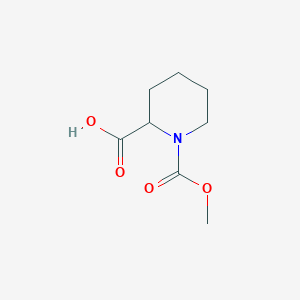
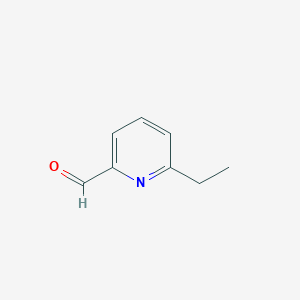
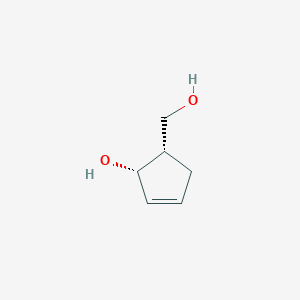
![6-Chloro-2,2,3,3-tetrafluoro-2,3-dihydro-benzo[1,4]dioxine](/img/structure/B138975.png)
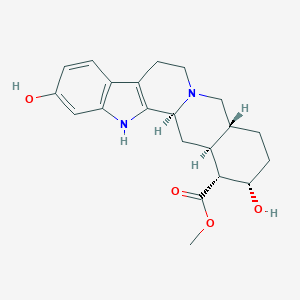
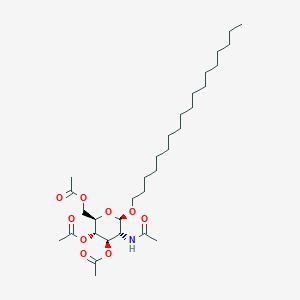
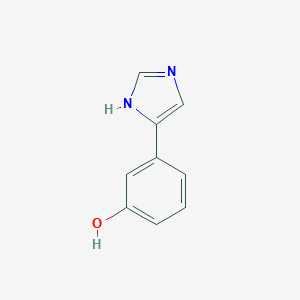
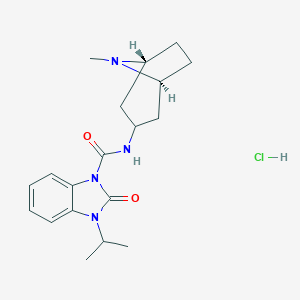
![N,N'-([1,2,5]Oxadiazolo[3,4-b]pyrazine-5,6-diyl)bis(hydroxylamine)](/img/structure/B138993.png)
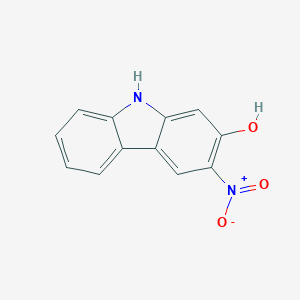

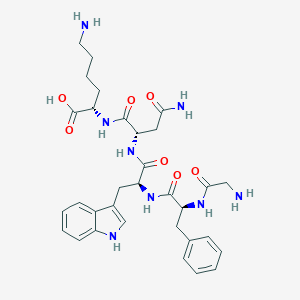
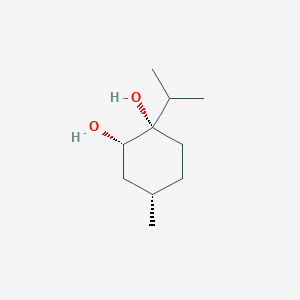
![(4S)-4-[[(1,1-Dimethylethoxy)carbonyl]amino]-5-hydroxypentanoic acid ethyl ester](/img/structure/B139007.png)
